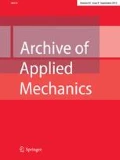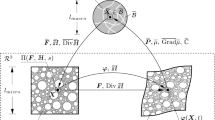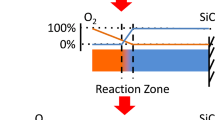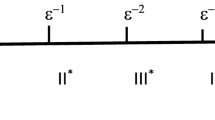Abstract
In the present contribution, we consider species diffusion coupled to finite deformations in strongly heterogeneous microstructures. A semi-dual energy formulation parameterized in terms of the chemical potential is obtained by Legendre transformation of the free energy. Doing so avoids the presence of higher gradients of the deformation field. The constitutive response at the macroscopic level is obtained using variationally consistent homogenization (Larson et al. in Int J Numer Method Eng 81(13):1659–1686, 2010. doi:10.1002/nme.2747). This approach allows to treat transient microscale problems on a representative volume element which has a finite size, i.e., the scales are not clearly separated. Full details of the implementation are provided. A series of numerical examples compares the homogenization results to single-scale formulations which fully resolve all microstructural features.










Similar content being viewed by others
Notes
It is assumed that no solid mass is produced, that is the identity \(\rho _0 \, \hbox {d}V= \rho _t \, \hbox {d}v\) relates the solid mass densities at the reference and current configuration via \(\rho _0 = J \rho _t\).
Quantities labeled by \({}^{\text {M}}{\{\bullet \}}\) belong to the macroscale.
Note that a physically motivated choice of the free energy function takes the form \(\psi ^{\text {chem}}(c) = A c\ln c + B c\). Nonetheless, the polynomial approach is computationally less expensive and is used in the following. This can be compared to the phenomenological approach of using a fourth-order polynomial to approximate the configurational free energy of a Cahn–Hilliard system rather than a logarithmic function, see the discussion in [28].
The concentration is evaluated in a nested loop at every quadrature point using a nonlinear Newton–Raphson solver. The update procedure is given by \(c \leftarrow c - [\psi ,{}_{cc}]^{-1}[\psi ,{}_c-\mu ]\).
References
Larsson, F., Runesson, K., Su, F.: Variationally consistent computational homogenization of transient heat flow. Int. J. Numer. Method. Eng. 81(13), 1659–1686 (2010). doi:10.1002/nme.2747
Aifantis, E.C.: On the problem of diffusion in solids. Acta Mech. 37(3), 265–296 (1980). doi:10.1007/BF01202949
Kojic, M., Milosevic, M., Kojic, N., Isailovic, V., Petrovic, D., Filipovic, N., Ferrari, M., Ziemys, A.: Transport phenomena: computational models for convective and diffusive transport in capillaries and tissue. In: De, S., Hwang, W., Kuhl, E. (eds.) Multiscale Modeling in Biomechanics and Mechanobiology, pp. 131–156. Springer, London (2015). doi:10.1007/978-1-4471-6599-6_7
Ubachs, R., Schreurs, P., Geers, M.: A nonlocal diffuse interface model for microstructure evolution of tin–lead solder. J. Mech. Phys. Solids 52(8), 1763–1792 (2004). doi:10.1016/j.jmps.2004.02.002
Salvadori, A., Bosco, E., Grazioli, D.: A computational homogenization approach for li-ion battery cells: part 1 - formulation. J. Mech. Phys. Solids 65, 114–137 (2014). doi:10.1016/j.jmps.2013.08.010
Chan, C.K., Peng, H., Liu, G., McIlwrath, K., Zhang, X.F., Huggins, R.A., Cui, Y.: High-performance lithium battery anodes using silicon nanowires. Nat. Nanotechnol. 3(1), 31–35 (2008)
Di Leo, C.V., Anand, L.: Hydrogen in metals: a coupled theory for species diffusion and large elastic-plastic deformations. Int. J. Plast. 43, 42–69 (2013). doi:10.1016/j.ijplas.2012.11.005
Di Leo, C.V., Rejovitzky, E., Anand, L.: A Cahn–Hilliard-type phase-field theory for species diffusion coupled with large elastic deformations: application to phase-separating li-ion electrode materials. J. Mech. Phys. Solids 70, 1–29 (2014). doi:10.1016/j.jmps.2014.05.001
Zhao, Y., Stein, P., Xu, B.-X.: Isogeometric analysis of mechanically coupled Cahn-Hilliard phase segregation in hyperelastic electrodes of li-ion batteries. Comput. Methods Appl. Mech. Eng. 297, 325–347 (2015). doi:10.1016/j.cma.2015.09.008
Miehe, C., Dal, H., Schänzel, L.-M., Raina, A.: A phase-field model for chemo-mechanical induced fracture in lithium-ion battery electrode particles. Int. J. Numer. Method. Eng. 106, 683–711 (2016)
Smit, R., Brekelmans, W., Meijer, H.: Prediction of the mechanical behavior of nonlinear heterogeneous systems by multi-level finite element modeling. Comput. Methods Appl. Mech. Eng. 155(1), 181–192 (1998). doi:10.1016/S0045-7825(97)00139-4
Kouznetsova, V., Brekelmans, W.A.M., Baaijens, F.P.T.: An approach to micro–macro modeling of heterogeneous materials. Comput. Mech. 27(1), 37–48 (2001). doi:10.1007/s004660000212
Miehe, C., Koch, A.: Computational micro-to-macro transitions of discretized microstructures undergoing small strains. Arch. Appl. Mech. 72(4), 300–317 (2002). doi:10.1007/s00419-002-0212-2
Miehe, C.: Computational micro-to-macro transitions for discretized micro-structures of heterogeneous materials at finite strains based on the minimization of averaged incremental energy. Comput. Methods Appl. Mech. Eng. 192(5–6), 559–591 (2003). doi:10.1016/S0045-7825(02)00564-9
Saeb, S., Steinmann, P., Javili, A.: Aspects of computational homogenization at finite deformations: a unifying review from reuss’ to voigt’s bound. Appl. Mech. Rev. 68(5), 050801 (2016)
Özdemir, I., Brekelmans, W.A.M., Geers, M.G.D.: Computational homogenization for heat conduction in heterogeneous solids. Int. J. Numer. Method. Eng. 73(2), 185–204 (2008). doi:10.1002/nme.2068
Özdemir, I., Brekelmans, W., Geers, M.: Computational homogenization for the thermo-mechanical analysis of heterogeneous solids. Comput. Methods Appl. Mech. Eng. 198(3–4), 602–613 (2008). doi:10.1016/j.cma.2008.09.008
Temizer, I., Wriggers, P.: Homogenization in finite thermoelasticity. J. Mech. Phys. Solids 59(2), 344–372 (2011). doi:10.1016/j.jmps.2010.10.004
Su, F., Larsson, F., Runesson, K.: Computational homogenization of coupled consolidation problems in micro-heterogeneous porous media. Int. J. Numer. Method. Eng. 88(11), 1198–1218 (2011). doi:10.1002/nme.3221
Sýkora, J., Krejčí, T., Kruis, J., Šejnoha, M.: Computational homogenization of non-stationary transport processes in masonry structures. J. Comput. Appl. Math. 236 (18) (2012) 4745 – 4755, FEMTEC 2011: 3rd International Conference on Computational Methods in Engineering and Science, May 9–13, 2011. doi:10.1016/j.cam.2012.02.031
Pham, K., Kouznetsova, V., Geers, M.: Transient computational homogenization for heterogeneous materials under dynamic excitation. J. Mech. Phys. Solids 61(11), 2125–2146 (2013). doi:10.1016/j.jmps.2013.07.005
Runesson, K., Ekh, M., Larsson, F.: Computational homogenization of mesoscale gradient viscoplasticity, Comput. Methods Appl. Mech. Eng. (2017)—Accepted for publication. doi:10.1016/j.cma.2016.11.032
Kaessmair, S., Steinmann, P.: Comparative computational analysis of the Cahn–Hilliard equation with emphasis on C1-continuous methods. J. Comput. Phys. 322, 783–803 (2016). doi:10.1016/j.jcp.2016.07.005
Saad, Y., Schultz, M.H.: GMRES: a generalized minimal residual algorithm for solving nonsymmetric linear systems. SIAM J. Sci. Stat. Comput. 7(3), 856–869 (1986)
Miehe, C.: Numerical computation of algorithmic (consistent) tangent moduli in large-strain computational inelasticity. Comput. Methods Appl. Mech. Eng. 134(3), 223–240, (1996). doi:10.1016/0045-7825(96)01019-5. http://www.sciencedirect.com/science/article/pii/0045782596010195
Kouznetsova, V., Geers, M., Brekelmans, W.: Multi-scale second-order computational homogenization of multi-phase materials: a nested finite element solution strategy. Comput. Methods Appl. Mech. Eng. 193(48–51), 5525–5550 (2004). doi:10.1016/j.cma.2003.12.073
Temizer, I., Wriggers, P.: On the computation of the macroscopic tangent for multiscale volumetric homogenization problems. Comput. Methods Appl. Mech. Eng. 198(3–4), 495–510 (2008). doi:10.1016/j.cma.2008.08.018
Gómez, H., Calo, V.M., Bazilevs, Y., Hughes, T.J.: Isogeometric analysis of the Cahn–Hilliard phase-field model. Comput. Methods Appl. Mech. Eng. 197(49–50), 4333–4352 (2008). doi:10.1016/j.cma.2008.05.003
Miehe, C., Mauthe, S., Ulmer, H.: Formulation and numerical exploitation of mixed variational principles for coupled problems of Cahn–Hilliard-type and standard diffusion in elastic solids. Int. J. Numer. Method. Eng. 99(10), 737–762 (2014). doi:10.1002/nme.4700
Lu, S., Pister, K.S.: Decomposition of deformation and representation of the free energy function for isotropic thermoelastic solids. Int. J. Solids Struct. 11(7–8), 927–934 (1975)
Acknowledgements
The authors gratefully acknowledge the support by the German Research Foundation (DFG) under Grant STE 544/48.
Author information
Authors and Affiliations
Corresponding author
Rights and permissions
About this article
Cite this article
Kaessmair, S., Steinmann, P. Computational first-order homogenization in chemo-mechanics. Arch Appl Mech 88, 271–286 (2018). https://doi.org/10.1007/s00419-017-1287-0
Received:
Accepted:
Published:
Issue Date:
DOI: https://doi.org/10.1007/s00419-017-1287-0




